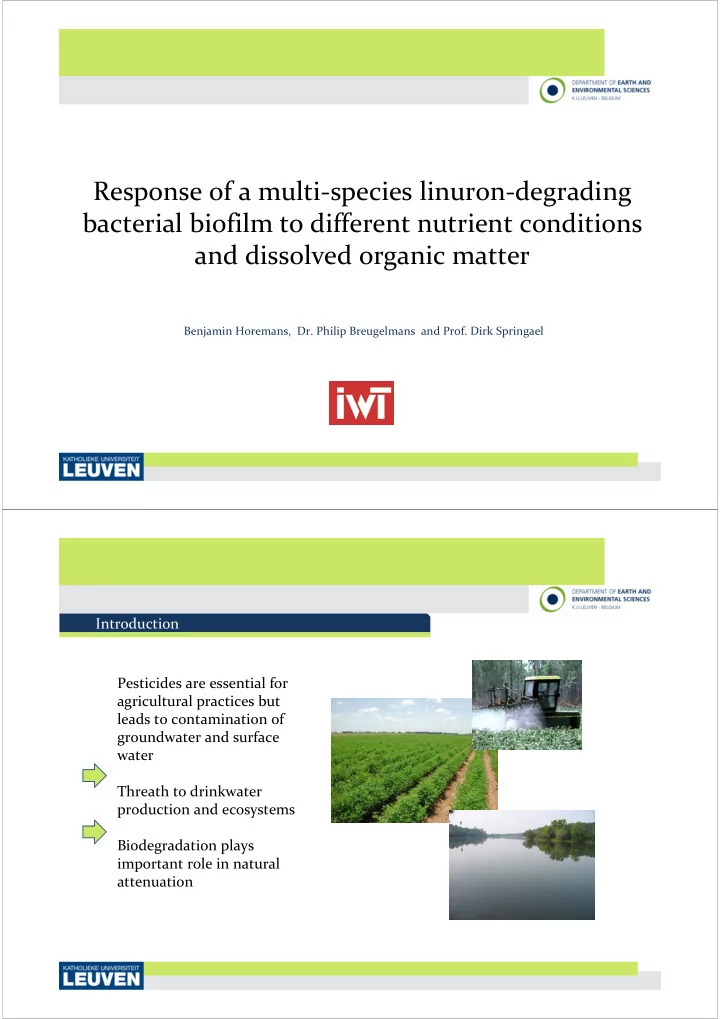

Response of a multi ‐ species linuron ‐ degrading bacterial biofilm to different nutrient conditions and dissolved organic matter Benjamin Horemans, Dr. Philip Breugelmans and Prof. Dirk Springael Introduction Pesticides are essential for agricultural practices but leads to contamination of groundwater and surface water Threath to drinkwater production and ecosystems Biodegradation plays important role in natural attenuation
Linuron ‐ degrading consortium Synergistic interaction Model pesticide • Linuron = systemic herbicide Variovorax sp. WDL1 • Toxic for aquatic organisms Model consortium: Variovorax sp. WDL1 Isolated from soil • C. testosteroni WDL7 • Synergistic degradation of linuron by three ‐ species consortium under H. sulfonivorans WDL6 planktonic conditions (Dejonghe et al., 2003) Linuron ‐ degrading consortium Synergistic interaction Under natural conditions microbial communities grow predominantly as biofilms Labscale simulation � growing communities as a biofilm in flow cells P. Dirckx (CBE) Acquisition of 3D ‐ images with CLSM and study of architecture and composition of biofilms
Linuron ‐ degrading consortium Labscale biofilm system + + Variovorax sp. WDL1 C. testosteroni WDL7 ‐ Rfp H. sulfonivorans WDL6 ‐ Yfp High ‐ Performance Liquid Confocal Laser Scanning Chromatography (HPLC) Microscopy (CLSM) Linuron ‐ degrading consortium Consortium biofilm development Day 0 Day 5 Day 13 Day 24 Day 31 0,12 0,12 concentration (mmol L ‐ 1 ) Linuron or 3,4 ‐ DCA 0,10 0,10 • Synergism under sessile 0,08 0,08 WDL1 only 0,06 0,06 conditions 0,04 0,04 Consortium • Required for complete 0,02 0,02 linuron degradation 0,00 0,00 0 0 5 5 10 10 15 15 20 20 25 25 30 30 35 35 40 40 Time (days)
Linuron ‐ degrading consortium Structure ‐ function relationship Linuron (0.1 mM) Citrate (0.1 mM) 6,8 17,3 43,7 46,3 75,9 10,0 Spatial organization under linuron ‐ fed conditions reflects metabolic interactions Effect of Additional C and/or N sources Linuron degradation Activity MM + Linuron + alternative HPLC C and/or N source ‐ N +N ‐ N ‐ N +N +N Linuron or 3,4 ‐ DCA degradation (%) Linuron 3,4 ‐ DCA 0.1 mM linuron 0.1 mM linuron 0.1 mM linuron + 0.1 mM citrate + 5 mM citrate
Effect of Additional C and/or N sources Biofilm Characteristics Linuron Linuron + N Linuron + 0.1 mM citrate Linuron + N Linuron Linuron + N + 0.1 mM citrate + 5 mM citrate + 5 mM citrate Effect of Temporal Exposure to starvation or alternative C and N source Linurondegradation Activity Linuron medium Alternative media HPLC (no linuron) 6 days ~30 days Initial irrigation Intermediate irrigation Final irrigation Operation Linuron 3,4 ‐ DCA medium medium medium time degradation degradation (days) (%) (%) 1 0.1 mM linuron C ‐ and N ‐ starved medium 0.1 mM linuron 11 66 ( ± 3) 84 ( ± 3) 2 0.1 mM linuron C ‐ starved medium 0.1 mM linuron 11 70 ( ± 4) 84 ( ± 2) 72 ( ± 2) 85 ( ± 2) 3 0.1 mM linuron N ‐ starved medium 0.1 mM linuron 14 86 ( ± 2) 90 ( ± 3) 4 0.1 mM linuron Alternative C and N source 0.1 mM linuron 11 (0.1 mM citrate + N)
Effect of Temporal Exposure to starvation or alternative C and N source Biofilm Characteristics Linuron C and N starvation C starvation N starvation N + 0.1 mM citrate Linuron Dissolved Organic Matter (DOM) Carbon and Energy Source Source of carbon, energy and nutrients (N, P) DOM for heterotrophic microbial communities Quantity = concentration Quality = biodegradability community composition and abundance enzymatic activity adaptation ? Pesticide degradation • Citric acid Increasing • Leachate of maize leaves recalcitrance • Extract of soil ‐ incubated maize leaves
Effect of DOM Quality and Quantity Planktonic conditions Linuron Effect of DOM on linuron degradation in MM + 0.08 mM linuron by 3,4 ‐ DCA strain Variovorax sp. WDL1 under planktonic conditions No TOC 0.4 mM DOC 1.6 mM DOC Citric acid Leachate Incubated Linuron degradation 3,4 ‐ DCA accumulation Conclusions Presence of easily ‐ degrabable carbon sources, besides linuron, negatively affects linuron ‐ degrading activity of consortium biofilms (concentration dependent) No full recovery of linuron ‐ degrading activity of consortium biofilms after intermittent exposure to nutrient ‐ starved or nutrient ‐ rich media � changes in biofilm biomass, organization and composition � particular biofilm characteristics for each condition DOM of natural origin enhances linuron ‐ degrading activity of V ariovorax sp. WDL1 under planktonic conditions
Thank you for your attention
Recommend
More recommend